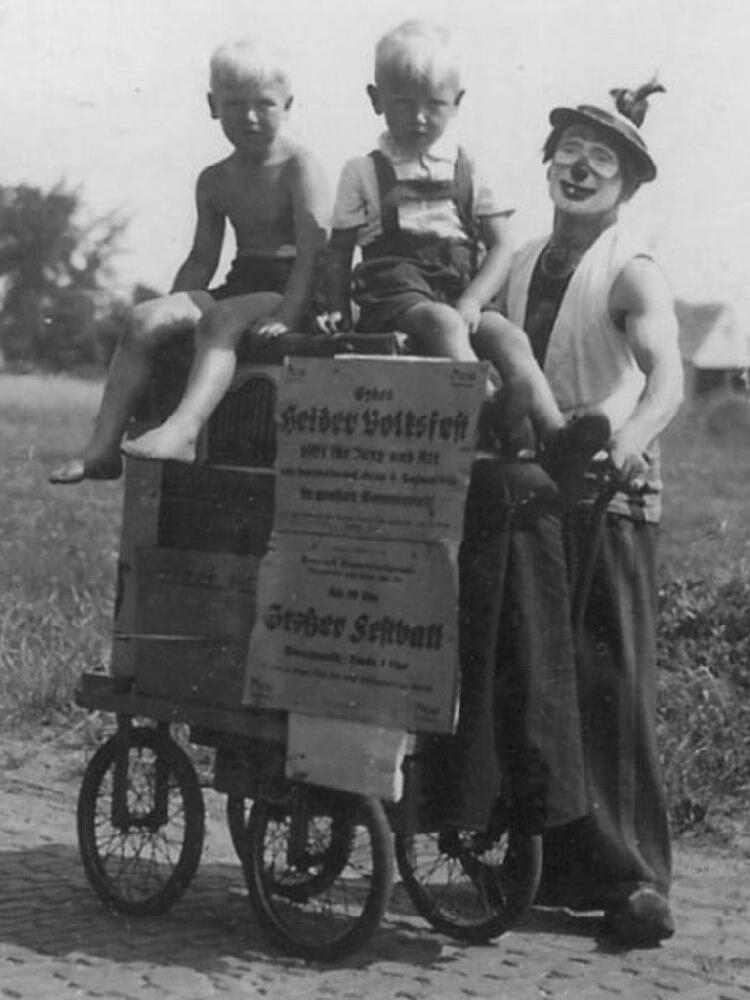
German Boys' Activities: Outings--The Circus

Figure 1.--This photo was taken in Schönemoor, a German village about 15 km west of Bremen. The clown is advertising a show that will take place during a popular festival on August 4, 1951. The little boys wear short pants. One wears regular shorts and is barefoot. The other wears h-bar shorts and I think sandals.
|
|
The circus has roots in ancient Rome and medieval traveling entertainers. There was in the 18th century a tradition of equestrian shows in Europe, including Germany. Trick riders were performing all over Europe as well as America. Jacob Bates was an English equestrian operating shows primarily in the German states, but took his show even to Russia (1764-65) and America (1772-73). Other showmen (Price, Johnson, Balp, Coningham, Faulkes, and "Old" Sampsonbegan) organizing similar shows. This appears to have been the inspiration for Philip Astley (1742-1814) who is generally credited with founding the modern circus in England. There was, however, from the beginning a pan-European basius for the cirfcus. Astley was a retired cavalry Sergeant-Major who became a showman. The noted German equestrian Carl Magnus Hinné (1819-90) established circuses in Frankfurt, Warsaw, and Copenhagen. He even founded circuses as far away as St. Petersburg and Moscow (1868). He was followed by the Italian brother-in-law, Gaetano Ciniselli (1815-81). German and Italian names thius became strongly associated with Russia. The Gautier family in France founded a Scandinavian circus dynasty. The German-sounding Schumanns (actually Sweeds) became a familiar name in Denmark, although the "Danish" Schumanns are Swedish. The first French circus dynasty was founded by an Italian--Antonio Franconi. All these cross border relations meant that acts from each individual countrieds appeared and were emulated throughout Europe. Trained bears were, for example, a traditional sct in Russia. Many of these differenta acts were merged into the original equestian trick shows to form the circus. The traveling circus and menagerie reached its peak in Europe in the inter-War era (1920s-30s). This was especially the case in Germany. The innovative traveling enterprises of Krone, Sarrasani and Hagenbeck dominated the German market. Not all circuses were family enterprises. Many German cities had large circus buildings. Sarrasani had a building in Dresden. Krone had a circus building in Münich. Hagenbeck had a facility in Stellingen. This was not only the case in Germzny. There wsere four permanent circuses operating in Paris. European circus goers, at least in the big cities, began to expect a degree of comfort and sophistication compsrable to the theater. The traveling American circus with its tents began to impact Europe. The traveling circus and tent brought the circus to much larger numbers of Europeans that was possible with big city performances. In Germany and other European countries there were not only large traveling circuses, but also much smaller operations which reached into rural areas and small villages.
HBC

Navigate the Boys' Historical Clothing Web Site:
[Return to the Main German outings page]
[Return to the Main German activities page]
[Return to the Main country outings page]
[Introduction]
[Biographies]
[Chronology]
[Clothing styles]
[Countries]
[Photography]
[Bibliographies]
[Contributions]
[FAQs]
[Glossaries]
[Images]
[Links]
[Registration]
[Tools]
[Boys' Clothing Home]
Created: 7:42 PM 6/12/2009
Last updated: 7:42 PM 6/12/2009



